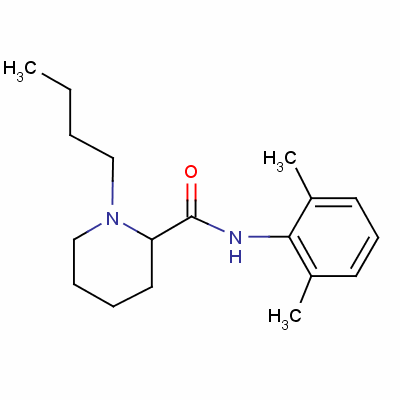Home > Offer to Sell > Pharmaceuticals and Biochemicals > Immunomodulator > 99% Local Anesthesia Drugs Bupivacaine for Infitration Anaesthesia CAS 2180-92-9
99% Local Anesthesia Drugs Bupivacaine for Infitration Anaesthesia CAS 2180-92-9
Inquiry
| Post Date: | Nov 20,2017 |
| Expiry Date: | Nov 20,2018 |
| Detailed Description: |
Cas No. :2180-92-9
Quantity: 1000Kilograms Specs:foil bag Price:1 USD Kilograms Payment Method: Western Union, money gram, t/t, bitcoin 99% Local Anesthesia Drugs Bupivacaine for Infitration Anaesthesia CAS 2180-92-9 Quick Details: Name Bupivacaine CAS No. 2180-92-9 Formula C18H28N2O Molecular Weight 288.43 Density 1.032 g/cm3 Boiling Point 423.4 °C at 760 mmHg Flash Point 209.9 °C Application Infiltrating anesthesia; Nerve block anesthesia Chemical structure Description: Bupivacaine is an anesthetic (numbing medicine) that blocks the nerve impulses that send pain signals to your brain. Bupivacaine is a long-acting local anaesthetic. Addition of epinephrine is thus rarely required. It blocks initiation and transmission of nerve impulses at the site of application by stabilizing the neuronal membrane. The compound is ultimately metabolized in the liver. Depending upon the site of injection and the concentration used, anaesthesia usually lasts 2-4 hours. Application: 1.It is related chemically and pharmacologically to the aminoacyl local anesthetics. It is a homologue of mepivacaine and is chemically related to lidocaine. All three of these anesthetics contain an amide linkage between the aromatic nucleus and the amino. They differ in this respect from the procaine-type local anesthetics, which have an ester linkage. Bupivacaine hydrochloride injection, USP - Sterile isotonic solution containing sodium chloride. The pH of the solution is adjusted to between 4 and 6.5 with sodium hydroxide or hydrochloric acid. 2.It is an anesthetic (numbing medicine) that blocks the nerve impulses that send pain signals to your brain. 3.It is used as a local (in only one area) anesthetic. 4.It is given as an epidural injection into the spinal column to produce numbness during labor, surgery, or certain medical procedures. 5.It is also used as an anesthetic for dental procedures. 6.It may also be used for purposes not listed in this medication guide. COA: Test Items Specification Test Results Appearance Fine, white, crystalline, odorless powder confirm Identification A\B\C in Pass confirm Solubility Very soluble in chloroform, soluble in Alcohol and Ether; insoluble in water confirm Melting point 106~110 degree 107.0~108.0 degree Related substance Not more than the reference solution 1.0% 0.40% Heavy metals ≤ 10ppm confirm Residue on ignition ≤ 0.10% 0.05% Loss on Drying ≤ 1.0% 0.20% Assay More Than 98.5 % 99.40% Conclusion Confirms USP32 How Does Bupivacaine Work? The drug works by blocking the impulses of the nerves that transmit the sensation of pain. This includes impeding both the creation of nerve impulses and their ability to travel throughout the body. It does this specifically by binding to channels that carry sodium to the nerves, thus stopping their progress. Bupivacaine provides additional numbing by also blocking some potassium channels. If Bupivacaine is administered incorrectly, bupivacaine can be cardiotoxic, which can result in damage to the muscles in and around the heart. The drug is not only ineffective when administered intravenously, but it has been known to be fatal. This is primarily because the drug does not work correctly when it is absorbed by the whole system instead of being administered locally. These risks are extremely low if the drug is injected as intended. Medical Usages Bupivacaine is indicated for local infiltration, peripheral nerve block, sympathetic nerve block, and epidural and caudal blocks. It is sometimes used in combination with epinephrine to prevent systemic absorption and extend the duration of action. The 0.75% (most concentrated) formulation is used in retrobulbar block. It is the most commonly used local anesthetic in epidural anesthesia during labor, as well as in postoperative pain management. Dosage and administration The aim is to administer the smallest effective dose. This varies with the procedure adopted, the degree of anaesthesia required, the rate of absorption from the injection site and the size and responsive-ness of the patient. Higher initial blood levels are attained with more concentrated solutions. The maximum cumulative safe dose for adults and children of a 0.25% solution of bupivacaine is 1.5 mg/kg. The table provides a general guide to dosage in adults. Smaller dosages should be administered to debilitated, elderly, epileptic and acutely ill patients. Bupivacaine is generally not recommended for children aged less than 12 years since there is insufficient information on the effects of its use in this age group. Solutions containing preservatives should not be used for spinal, epidural or caudal anaesthesia. Local Anesthetic list Name CAS Articaine hydrochloride 23964-57-0 Benzocaine 94-09-7 Benzocaine hydrochloride 23239-88-5 Bupivacaine 2180-92-9 Bupivacaine hydrochloride 14252-80-3 Dibucaine hydrochloride 61-12-1 Levobupivacaine hydrochloride 27262-48-2 Lidocaine 137-58-6 Lidocaine hydrochloride 73-78-9 Pramoxine hydrochloride 637-58-1 Prilocaine 721-50-6 Procaine 59-46-1 Procaine hydrochloride 94-09-7 Proparacaine hydrochloride 5875-06-9 Propitocaine hydrochloride 1786-81-8 Ropivacaine hydrochloride 132112-35-7 Tetracaine 94-24-6 Tetracaine hydrochloride 136-47-0 |
| CAS Registry Number: | 2180-92-9 |
| Synonyms: | ;Bupivacaine [INN:BAN];Bupivacaine;(+-)-Bupivacaine;1-Butyl-2',6'-pipecoloxylidide;AH 250;Anekain;Bupivacaina;Bupivacaina [INN-Spanish];Bupivacainum;Bupivacainum [INN-Latin];DL-Bupivacaine;UNII-Y8335394RO;Win 11318;dl-1-Butyl-2',6'-pipecoloxylidide;(1)-1-Butyl-N-(2,6-dimethylphenyl)piperidine-2-carboxamide;2',6'-Pipecoloxylidide, 1-butyl-;2-Piperidinecarboxamide, 1-butyl-N-(2,6-dimethylphenyl)-;2-Piperidinecarboxamide, 1-butyl-N-(2,6-dimethylphenyl)-, (+-)-;Bupivacaine (base and/or unspecified salts);1-butyl-N-(2,6-dimethylphenyl)piperidine-2-carboxamide;3-butyl-N-(2,6-dimethylphenyl)piperidine-2-carboxamide; |
| Molecular Formula: | C18H28N2O |
| Molecular Weight: | 288.432 |
| Molecular Structure: | 
|
| Company: | Hengyang Desen Biotechnology Co., Ltd. [ China ] |
| Contact: | Koala |
| Tel: | +86-073-48164621 |
| Fax: | 027-88608190-722 |
| Email: | koala@desen-nutrition.com |
-
Disclaimer statement:The information and data included above have been realized by the enterprises and compiled by the staff, and are subject to change without notice to you. The Chemnet makes no warranties or representations whatsoever regarding the facticity, accuracy and validity of such information and data. In order to ensure your interest, we suggest you chose the products posted by our gold suppliers or VIP members.


